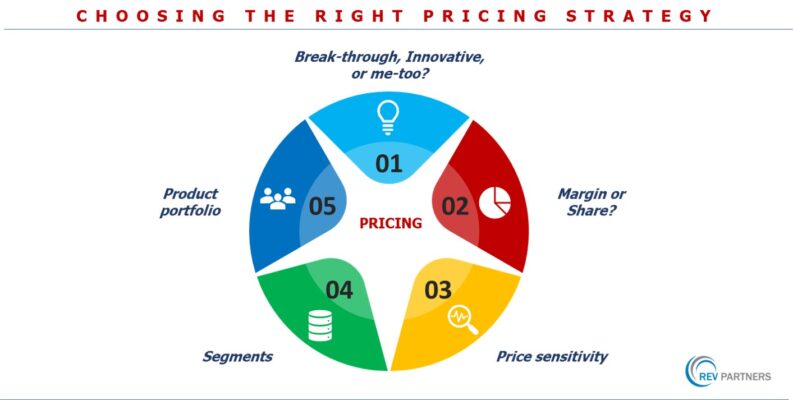Harness the Power of Pricing
The Critical Role of Pricing: Pricing has a significant impact on a company’s profitability, and the importance of the power of pricing cannot be overstated. In an increasingly transparent market, the temptation to compete solely on price is ever-present. However, it is crucial to remember that there will always be competitors offering lower prices. The real question is: how far are you willing to go to compete?
Successful companies take a more strategic approach to pricing, staying true to their revenue goals. These organizations avoid price wars and generic pricing structures by choosing a winning strategy from the onset. They leverage digitalization to identify new opportunities and incorporate psychological factors into their pricing models to create a distinct and competitive offering.
By gaining a comprehensive understanding of pricing’s importance, you can better guide your sales teams towards sustainable price points, adequately prepare for price increases, and ultimately drive higher revenues and profits. Establishing a consistent narrative around price, the value you provide, and the premium you deserve for your products and services is essential. Consider investing in pricing as an investment in your company’s future.
Choosing the Right Pricing Strategy
All groundbreaking innovations require an effective pricing strategy. However, determining the ideal price for a product that has never been sold before can be challenging. Many companies fall into the trap of delaying the pricing decision until the last minute, leaving little time for thorough analysis or research. A well-defined pricing strategy is crucial as it sets the stage for the product’s entire lifecycle. The choice typically boils down to two strategies: skimming or penetration pricing.

Many businesses struggle to succeed with a penetration pricing strategy, as it can be risky from a profitability standpoint. Companies need to have a clear plan for future price increases and maintain focus on long-term monetization strategies. To make an informed decision, consider these five factors:
Break-through, Innovative, or me-too?
A unique, proprietary solution lacks a reference price and direct competition, allowing you to create and penetrate a new market. On the other hand, undifferentiated “me-too” products face numerous competitors. A skimming strategy may only be viable if your offering provides superior value.
Margin or Share?
Trade-offs are inevitable, as not all objectives can be pursued simultaneously. Some companies may face production capacity constraints during the launch phase, while others with high capital expenditure requirements must meet cash flow targets. In these cases, a “safe bet” penetration strategy might be more appropriate than a skimming strategy.
Price sensitivity
Penetration pricing can be effective if a lower price results in substantially higher sales volume or customer base. The market must be sensitive enough to offset the lower margin. Skimming is more suitable when demand demonstrates low price elasticity, allowing you to secure profits through a high price until your product gains a market position.
Segments
Some customers may not want to wait for a product to become mainstream, preferring to showcase the latest technology to their peers. Similarly, B2B companies might seek state-of-the-art technology for a competitive edge. Early adopters might be willing to pay a premium, making a skimming strategy more fitting when there is a significant difference in willingness to pay among segments.
Product portfolio
Some products cannot be launched in isolation from the rest of your portfolio. Account for portfolio and cannibalization effects, as well as the order of product launches.
The decision to implement a penetration or skimming pricing strategy has far-reaching consequences, shaping your product’s entire lifecycle and economic outcome. Your choice could determine the success or failure of a new product – it is a decision that warrants careful consideration.
Leverage Market Analysis & Competitive Intelligence
In addition to choosing the right pricing strategy, businesses should also consider market analysis and competitive intelligence. Gathering and analyzing data on competitors’ pricing, product offerings, and marketing strategies can provide invaluable insights for refining your approach.
Competitive Landscape
Thoroughly analyze the competitive landscape to identify potential market opportunities, pricing trends, and gaps in the market. Understanding your competition allows you to differentiate your offerings, adopt competitive pricing strategies, and make informed decisions.
Consumer Behavior
Understand your target audience’s preferences, purchasing habits, and price sensitivities. This knowledge enables you to tailor your pricing strategy to the market, maximize customer satisfaction, and increase the perceived value of your products and services.
Market Positioning
Establish a clear market position for your company and products by aligning your pricing strategy with your brand image, product quality, and target audience. This approach ensures consistency and reinforces the perceived value of your products in the eyes of your customers.
Innovative Pricing Models and Digital Tools
To stay ahead of the competition, businesses should also consider exploring innovative pricing models to harness the power of pricing and leveraging digital tools to optimize their pricing strategies. Dynamic pricing, subscription models, and value-based pricing are just a few examples of alternative pricing structures that can be employed to maximize revenue.
Dynamic Pricing
Dynamic pricing adjusts prices based on real-time supply and demand, consumer behavior, or other market factors. This approach can help businesses stay agile and responsive to market fluctuations and customer preferences.
Subscription Models
Subscription pricing models generate recurring revenue, improve customer retention, and can be tailored to cater to various customer segments. Offering a range of subscription tiers with different features and benefits allows you to target diverse consumer needs and preferences.
Value-based Pricing
Value-based pricing focuses on the perceived value of a product or service, rather than solely considering production costs or competitor prices. This strategy can help businesses justify higher price points and increase customer satisfaction by highlighting the unique benefits and value they provide.
Digital Pricing Tools
Harness the power of technology to support your pricing strategies. Analytics tools, artificial intelligence, and machine learning can help you analyze data, identify trends, and optimize pricing for maximum profitability.
In conclusion, pricing is a critical aspect of business success, and the right strategy to leverage the power of pricing can significantly impact a company’s bottom line. By understanding the importance of pricing, considering various factors in determining your pricing approach, and leveraging innovative models and digital tools, your organization can optimize profits and achieve long-term success in a competitive market.
——————————————————————————————————————————-
ABOUT REV PARTNERS
REV Partners. Business Transformation Experts. Digital Transformation Experts. We are a Management Consulting & Advisory firm. We help Fortune 500 & Private Equity clients address the most pressing issues related to Transformation, Strategy, Operations, Organization and Digital. We can also provide experienced experts as Interim “Chief Transformation Officer” or equivalent, to accelerate, lead and execute ambitious Business Transformation or Digital Transformation programs. If you or your organization need support, please contact us, follow us on Twitter, or Email us at meet@revpartners.com.
© REV Partners. All Rights Reserved.

